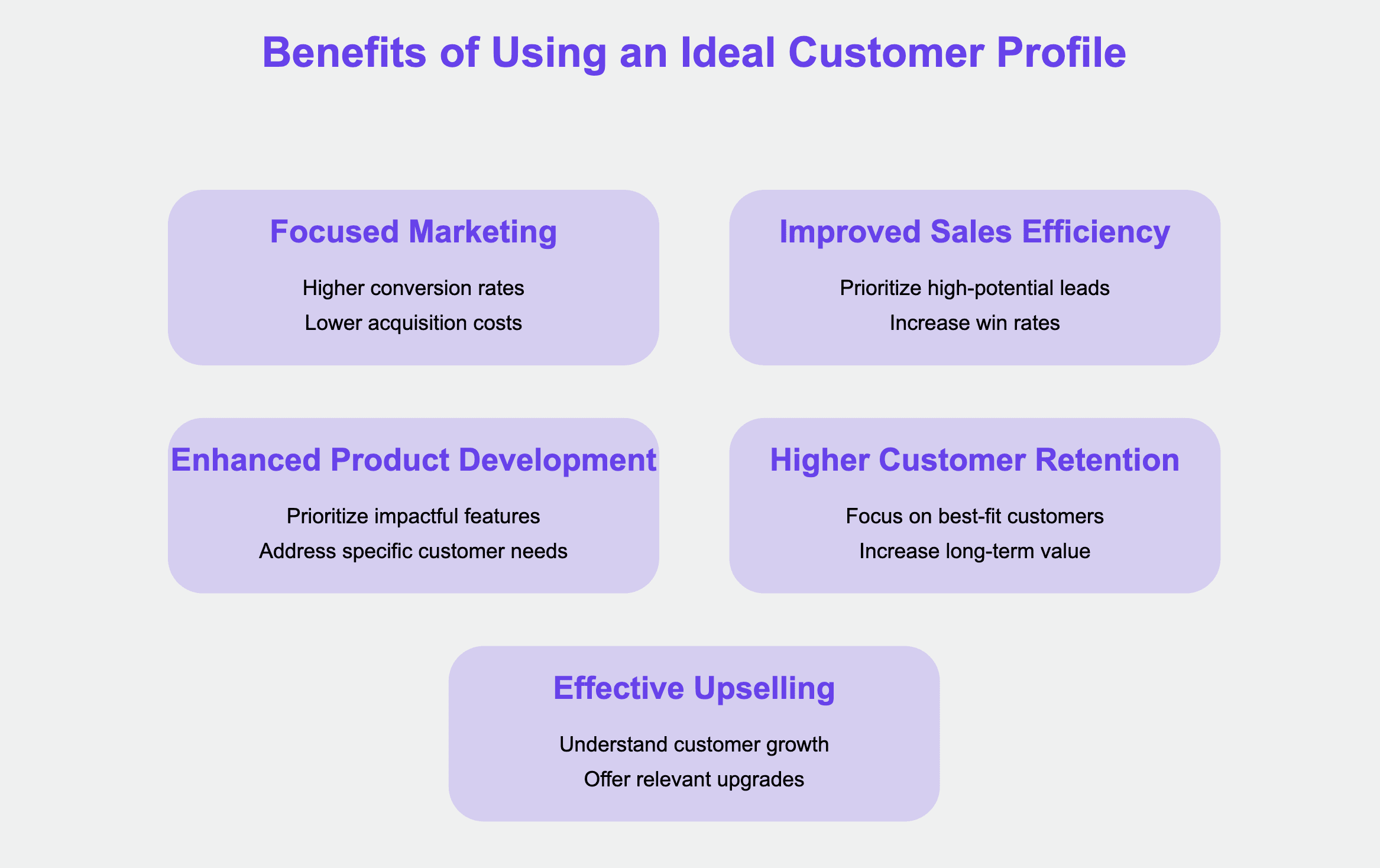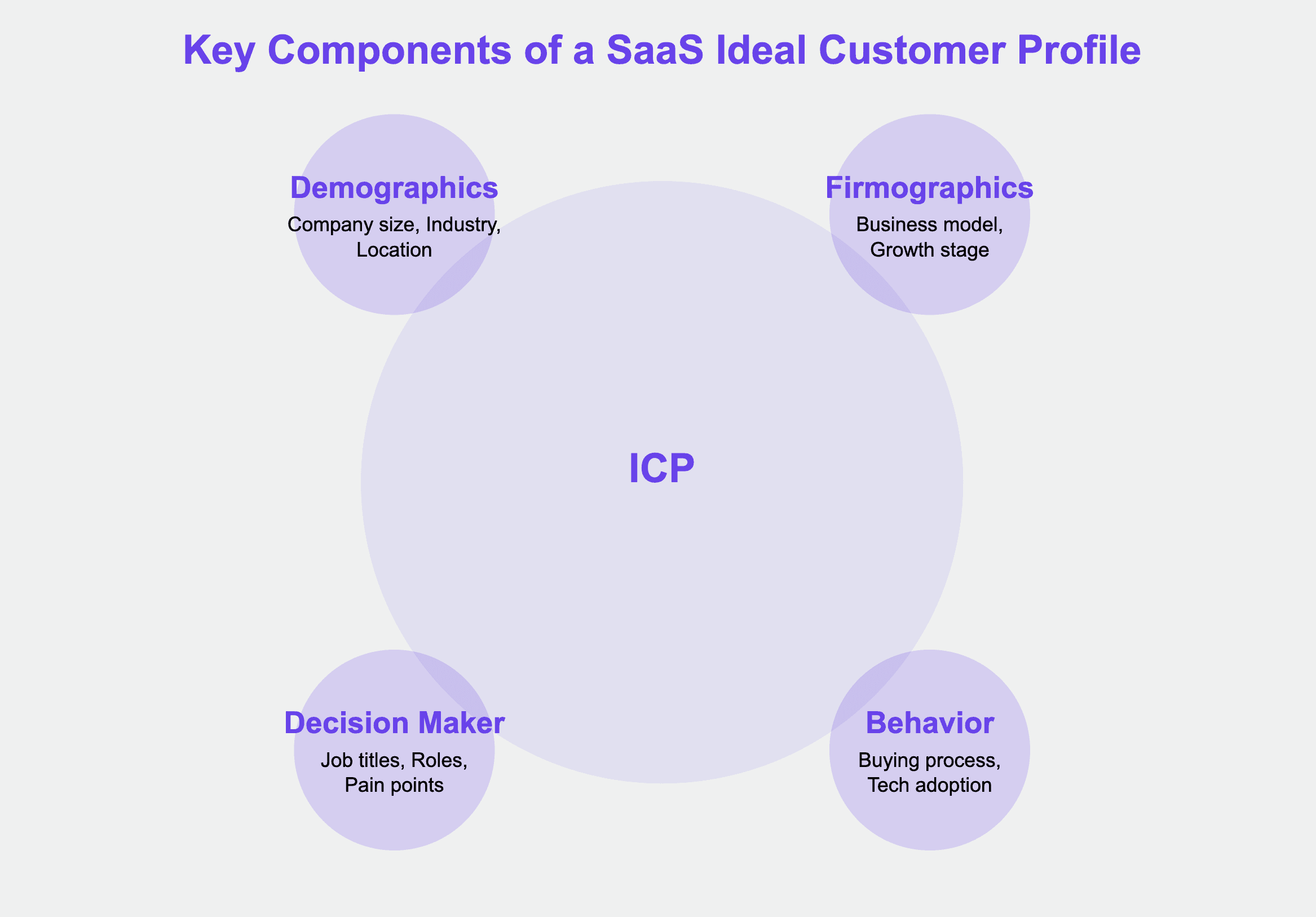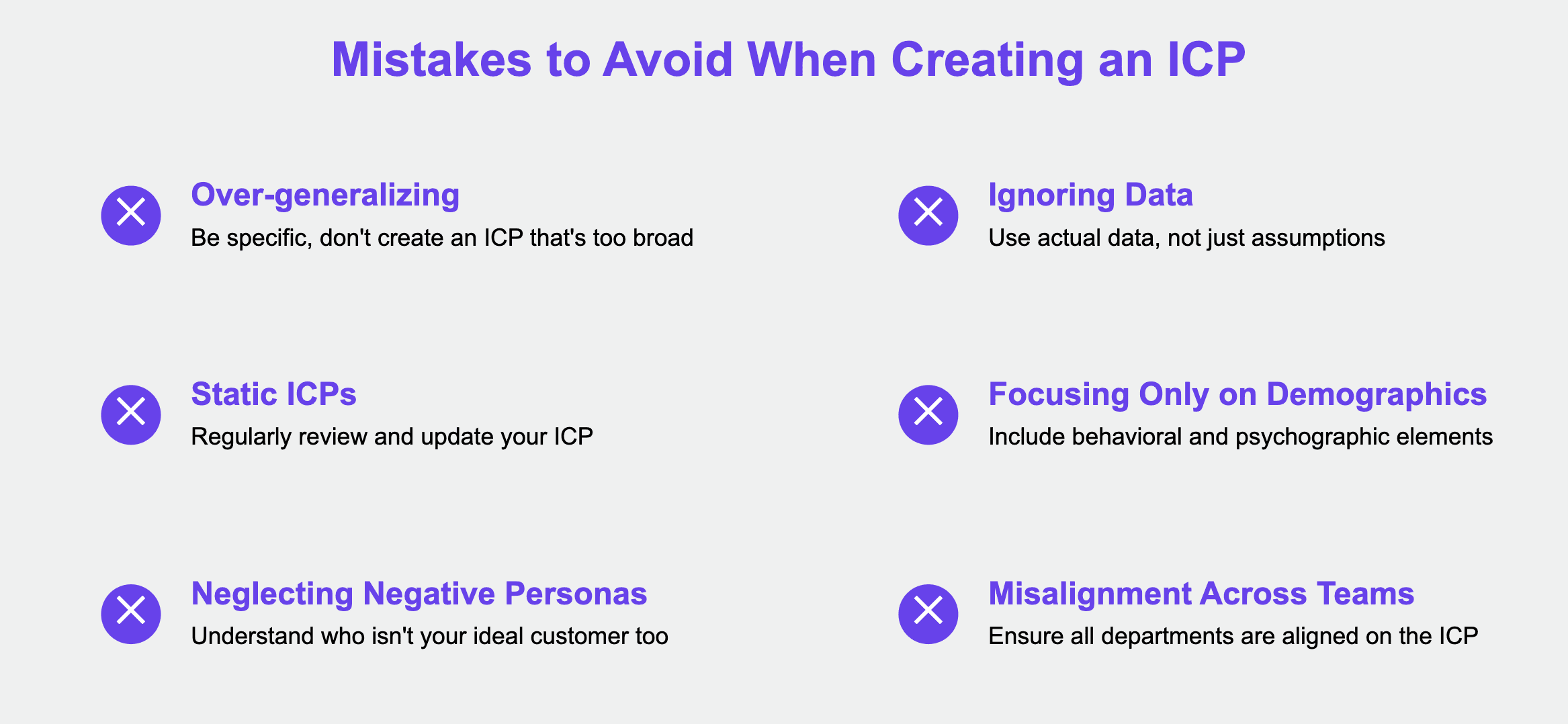
SaaS Ideal Customer Profiles: A Comprehensive Guide

par
Aleksa Mitrović
7 oct. 2024
Identifiez et convertissez vos utilisateurs les plus importants
Créer un compte
1. Definition and Importance of ICP

Understanding your customer base is crucial for success. One of the most powerful tools in achieving this understanding is the Ideal Customer Profile (ICP). But what exactly is an ICP, and why is it so important?
An Ideal Customer Profile is a detailed description of the type of customer that would benefit most from your product or service. It's not just a vague idea of who might use your SaaS offering, but a well-defined model of your perfect customer. This profile encompasses various characteristics, including demographic information, behavioral patterns, and specific needs that your product addresses.
The importance of an ICP cannot be overstated. It serves as a guiding light for virtually every aspect of your SaaS business, including:
Marketing: Helps focus your efforts on the most promising prospects
Product Development: Informs feature prioritization and roadmap planning
Customer Success: Guides onboarding and retention strategies
By defining your ICP, you're essentially creating a blueprint for your entire business strategy. It allows you to allocate resources more efficiently, tailor your messaging more effectively, and ultimately, drive growth by focusing on the customers who are most likely to succeed with your product.
2. Data Collection for ICP Creation
Creating an accurate and useful ICP requires a wealth of data. This data comes from various sources, which can be broadly categorized into two types: first-party data and third-party data.
First-Party Data
First-party data is information that you collect directly from your customers or potential customers. This includes:
Browser Tracking: Information about the user's location, device type, and operating system.
Product Usage Data: How customers interact with your product, including features they use most frequently and time spent on various tasks.
Onboarding Questions: Responses to questions asked during the sign-up process, such as company size, intended use case (professional or hobby), and role within the organization.
Third-Party Data
Third-party data comes from external sources and can provide additional context and depth to your ICP. Some valuable sources include:
LinkedIn: Professional information such as job titles, company sizes, and industry sectors.
GitHub: For tech-focused SaaS products, GitHub can provide insights into programming languages and technologies used by potential customers.
Instagram and other social media: Follower counts and engagement rates can be useful for products targeting influencers or marketers.
The key to effective ICP creation is combining these data sources to build a comprehensive picture of your ideal customer. For example, you might use first-party data to understand how customers use your product, and then enrich this with LinkedIn data to understand their professional context.
3. Benefits of ICP

Developing and utilizing an Ideal Customer Profile offers numerous benefits for SaaS companies:
Focused Marketing Efforts: With a clear ICP, you can create highly targeted marketing campaigns that resonate with your ideal customers. This leads to higher conversion rates and lower customer acquisition costs.
Enhanced Product Development: By understanding the specific needs and pain points of your ideal customers, you can prioritize features and improvements that will have the most significant impact.
Streamlined Onboarding: Knowing your ideal customer allows you to create onboarding experiences tailored to their needs, increasing the likelihood of successful product adoption.
Higher Customer Retention: When you focus on acquiring customers who closely match your ICP, they're more likely to find long-term value in your product, leading to higher retention rates.
More Effective Upselling and Cross-selling: Understanding your ideal customers' needs and growth trajectories allows you to offer relevant upgrades and additional services at the right time.
Improved Customer Feedback: Feedback from customers who match your ICP is likely to be more relevant and actionable, helping guide your product roadmap more effectively.
By leveraging these benefits, SaaS companies can create a virtuous cycle of attracting, retaining, and growing relationships with their most valuable customers.
4. Key Components of a SaaS ICP

A comprehensive SaaS ICP typically includes the following key components:
Demographics:
Company size (number of employees, revenue)
Industry or vertical
Geographic location
Firmographics:
Business model (B2B, B2C, etc.)
Growth stage (startup, established, enterprise)
Technological maturity
Decision Maker Profile:
Job titles of key decision-makers
Roles and responsibilities
Pain points and challenges
Buying process and decision-making style
Preferred communication channels
Technology adoption patterns
Goals and Objectives:
Key performance indicators (KPIs)
Short-term and long-term business objectives
Budget and Pricing Sensitivity:
Typical budget allocation for similar solutions
Willingness to pay for value-added features
Technical Requirements:
Integration needs
Security and compliance requirements
Scalability expectations
Success Metrics:
How they define and measure success with your product
Expected ROI or other value metrics
Competitive Landscape:
Current solutions in use
Competitors they're considering
Customer Journey:
Typical path to discovering and adopting your solution
Key touchpoints and interactions with your company
By combining these components, you create a holistic view of your ideal customer that goes beyond basic demographics. This detailed profile allows you to make data-driven decisions across all aspects of your business, from product development to customer success strategies.
5. Mistakes to Avoid

While creating and using an ICP can be incredibly beneficial, there are several common mistakes that SaaS companies should be aware of and avoid:
Over-generalizing: Creating an ICP that's too broad can defeat the purpose. Be specific and don't be afraid to exclude segments that aren't ideal fits.
Ignoring Data: Basing your ICP on assumptions rather than actual data can lead to misaligned strategies. Always use a combination of quantitative and qualitative data to inform your ICP.
Static ICPs: Markets and customer needs evolve. Regularly review and update your ICP to ensure it remains relevant.
Focusing Only on Demographics: While important, demographics alone don't tell the whole story. Include behavioral and psychographic elements in your ICP for a more complete picture.
Neglecting Negative Personas: Understanding who isn't your ideal customer is just as important as knowing who is. Create negative personas to help your team identify poor-fit prospects early.
Misalignment Across Teams: Ensure all departments (marketing, product, customer success) are aligned on the ICP to maintain consistency in messaging and strategy.
Ignoring Customer Feedback: Your existing customers, especially the most successful ones, can provide invaluable insights for refining your ICP. Don't overlook their input.
Overcomplicating the ICP: While it should be comprehensive, an overly complex ICP can be difficult to use effectively. Strike a balance between detail and usability.
Not Differentiating Between ICP and Buyer Personas: ICPs are typically company-level profiles, while buyer personas focus on individuals. Both are important but serve different purposes.
Failing to Act on the ICP: Creating an ICP is just the first step. Ensure you have processes in place to operationalize the ICP across all customer-facing functions.
By avoiding these mistakes, you can create and maintain an effective ICP that drives real business results. Remember, the goal of an ICP is not just to describe your ideal customer, but to guide your entire organization in attracting, serving, and retaining those customers who will drive the most value for your SaaS business.
In conclusion, an Ideal Customer Profile is a powerful tool for SaaS companies looking to focus their efforts and resources on the most promising opportunities. By leveraging both first-party and third-party data, creating a comprehensive profile, and avoiding common pitfalls, you can use your ICP to drive growth, improve customer satisfaction, and achieve long-term success in the competitive SaaS landscape.




